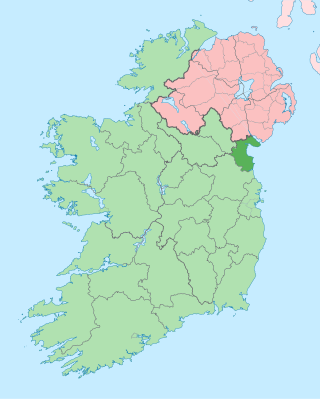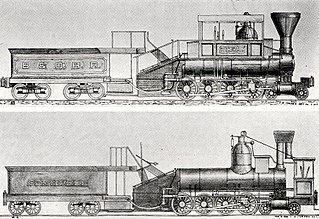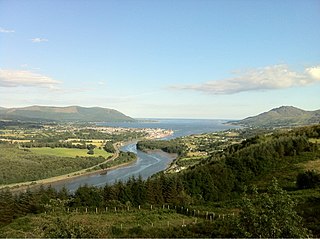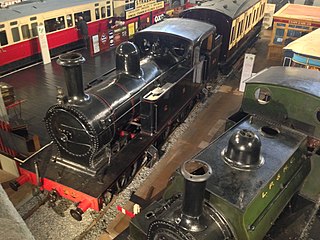Related Research Articles

Dundalk is the county town of County Louth, Ireland. The town is on the Castletown River, which flows into Dundalk Bay on the east coast of Ireland. It is halfway between Dublin and Belfast, close to the border with Northern Ireland. It is surrounded by several townlands and villages that form the wider Dundalk Municipal District. It is the seventh largest urban area in Ireland, with a population of 43,112 as of the 2022 census.

NI Railways, also known as Northern Ireland Railways, is the railway operator in Northern Ireland. NIR is a subsidiary of Translink, whose parent company is the Northern Ireland Transport Holding Company (NITHCo), and is one of eight publicly owned train operators in the United Kingdom, the others being Direct Rail Services, Northern Trains, Transport for Wales Rail, Southeastern, LNER, ScotRail, and TransPennine Express. It has a common Board of Management with the other two companies in the group, Ulsterbus and Metro.

County Louth is a coastal county in the Eastern and Midland Region of Ireland, within the province of Leinster. Louth is bordered by the counties of Meath to the south, Monaghan to the west, Armagh to the north and Down to the north-east, across Carlingford Lough. It is the smallest county in Ireland by land area and the 17th most populous, with just over 139,100 residents as of 2022. The county is named after the village of Louth. Louth County Council is the local authority for the county.

Rail transport in Ireland is provided by Iarnród Éireann in the Republic of Ireland and by Northern Ireland Railways in Northern Ireland.

Iarnród Éireann, or Irish Rail, is the operator of the national railway network of Ireland. Established on 2 February 1987, it is a subsidiary of Córas Iompair Éireann (CIÉ). It operates all internal InterCity, Commuter, DART and freight railway services in the Republic of Ireland, and, jointly with Northern Ireland Railways, the Enterprise service between Dublin and Belfast. In 2019, IÉ carried a record peak of 50 million passengers, up from 48 million in 2018.

Under the Whyte notation for the classification of steam locomotives, 4-8-0 represents the wheel arrangement of four leading wheels on two axles, usually in a leading truck or bogie, eight powered and coupled driving wheels on four axles and no trailing wheels. In North America and in some other countries the type was usually known as the Twelve-wheeler.

Carlingford Lough is a glacial fjord or sea inlet in northeastern Ireland, forming part of the border between Northern Ireland to the north and the Republic of Ireland to the south. On its northern shore is County Down, the Mourne Mountains, and the town of Warrenpoint; on its southern shore is County Louth, the Cooley Mountains and the village of Carlingford. The Newry River flows into the loch from the northwest.

The British Rail Class 150 Sprinter is a class of diesel-hydraulic multiple unit passenger trains, developed and built by British Rail Engineering Limited at York Carriage Works between 1984 and 1987 for use on regional services across Great Britain. The type is a second-generation design, built to more modern standards and based on BR's Mark 3 body design for longer-distance services. It was developed alongside the lower-cost Pacers, which were built using bus parts, for use on short-distance services. Two prototype units were built, followed by 135 production units in two batches. Subsequently, further members of the Sprinter family were developed and introduced to service, including the Class 155, Class 156, Class 158 and Class 159.

The Great Eastern Railway (GER) Class Y14 is a class of 0-6-0 steam locomotive. The LNER classified them J15.

Belturbet is a town in County Cavan, Ireland. It lies on the N3 road, around 14 km (8.7 mi) north of Cavan town and 123 km (76 mi) from Dublin. It is also located around 4 km (2.5 mi) south of the border with County Fermanagh, part of Northern Ireland, and is 36 km (22 mi) from Enniskillen. As of the 2022 census, the population was 1,610.

The Great Northern Railway (Ireland) (GNR(I) or GNRI) was an Irish gauge (1,600 mm (5 ft 3 in)) railway company in Ireland. It was formed in 1876 by a merger of the Irish North Western Railway (INW), Northern Railway of Ireland, and Ulster Railway. The governments of Ireland and Northern Ireland jointly nationalised the company in 1953, and the company was liquidated in 1958: assets were split on national lines between the Ulster Transport Authority and Córas Iompair Éireann.
The Belfast and Northern Counties Railway (BNCR) Class A was a class of 13 two-cylinder compound steam locomotives built for service in north-east Ireland. The first two members of the class would be the last locomotives to be built for the independent BNCR, being completed before its purchase by the Midland Railway in 1903. The members of the class were rebuilt by the LMS (NCC) becoming either Class A1 or Class U2 depending on how they had been modified.

The Northern Counties Committee (NCC) Class U2 4-4-0 passenger steam locomotives consisted of 18 locomotives built for service in north-east Ireland. Ten of the engines were new builds supplied by the North British Locomotive Company (NBL) or constructed at the NCC's York Road works. The remainder were rebuilds of existing locomotives.

The GNR(I) Q Class 4-4-0 steam locomotives of the Great Northern Railway (Ireland) (GNR) were mainly used on cross-border mixed traffic duties between Dublin and Belfast, as well as the "Derry Road" between Portadown and Derry. It was designed for the GNR under the auspices of Charles Clifford and built by Neilson, Reid and Company, North British Locomotive Company and Beyer, Peacock and Company. The Q Class is slightly smaller than the GNR class S 4-4-0 but powerful enough to haul a rake of eight or more carriages.

The GS&WR Class 101, classified as Class 101 or Class J15 by the Great Southern Railways, was a class of 0-6-0 steam locomotives designed for working goods traffic although they did, and were quite capable of, working branch and secondary passenger trains.

Dublin and Drogheda Railway (D&D) was a railway company in Ireland which publicly opened its 31¾ mile main line between Dublin and Drogheda in May 1844. It was the third railway company in Ireland to operate passenger trains and the first to use the Irish standard 5 ft 3 in gauge. It later opened branches to Howth and Oldcastle. The opening of the Dublin and Belfast Junction Railway (D&BJct) between the D&D at Drogheda and the Ulster Railway (UR) at Portadown in 1852 saw an almost continuous main line connection between Dublin and Belfast, which was resolved by the official opening of the Boyne Viaduct in April 1855. Amalgamations between these and other companies in 1875 and 1876 saw the creation of the Great Northern Railway of Ireland GNR(I).
The LMS (Northern Counties Committee)Class A1 4-4-0 passenger steam locomotives were rebuilds of Belfast and Northern Counties Railway Class A two-cylinder compound locomotives. They operated services throughout the NCC’s 5 ft 3 in (1,600 mm) broad gauge system in the north-east of Ireland.

Ardee railway station was a railway station which served Ardee in County Louth, Ireland. It was the terminus of a branch which diverged from the Belfast-Dublin line at Dromin Junction.

The 26 miles (42 km) Dundalk, Newry and Greenore Railway was an Irish gauge railway in Ireland. It was conceived in the 1860s to provide a link between the towns in its title and the London and North Western Railway port at Greenore, from where a ferry service operated to Holyhead. It was opened between Greenore and Dundalk in 1873 and extended to Newry in 1876. The company operated a hotel at Greenore.

The Great Northern Railway (Ireland) JT class comprised six 2-4-2T locomotives, all built between 1895 and 1902 at their Dundalk Works. These were of a J. C. Park design, but introduced following his death. They were used on Dublin suburban services; then on branch lines, including operation of the Dundalk, Newry and Greenore Railway when taken over in 1933. Most were withdrawn shortly after 1955 between 1955 and 1957 but one remained passed to Córas Iompair Éireann (CIÉ) and remained in service until 1963.
References
- ↑ "Trains lined up at sheds, Adelaide, Co. Antrim". National Library of Ireland on flickr. 27 July 2015.
- ↑ Louth County Archives Service historian. The Paddy Mallon – Great Northern Railway (Ireland) Collection, 1836 – 1984 (PDF) (Report). Louth County Archives Service. Archived from the original (PDF) on 21 September 2015. Retrieved 28 July 2015.